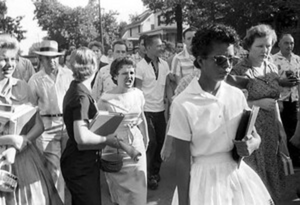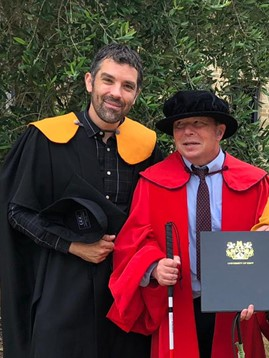Alternative text is used to provide text descriptions for images. This can provide an alternative for blind users and often provide additional or clarifying information when presented as a visible caption underneath or accompanying an image.
One challenge which we regularly receive questions about is how to describe people when using alternative text. These questions often cover describing race, gender, and physical features.
In general, the rules to follow when describing people are simple. The two rules to live by when considering describing people in alternative text are respect and context.
- Respect – When thinking about describing a person, remember that they are still a person and should be treated with respect. How would they prefer to be described? What are appropriate, neutral, or polite terms to refer to how someone looks?
- Context – When thinking about what attributes of a person’s appearance to describe, why are they important to the description? Is someone’s, weight, clothing, race, gender identity, hairstyle, or expression relevant to the purpose of your use of their image?
In the examples below, we share some of the challenges and situations we have encountered when writing alternative text descriptions for images of people. These examples cover race, gender and pronouns, profile pictures and physical features.
Describing race presents several challenges in general and in specific situations where you think the context may mean referring to race is relevant. As with all examples in this guide we want to refer to the main rules of respect and context.
The following examples will present different contexts where race may play a factor in the alternative text description and what you may want to consider in how you refer to someone’s race when writing alt text.
Race in context – race relations example
One of the most commonly shared articles about race and alternative text descriptions is “The case for describing race in alternative text attributes” by Tolu Adegbite.
Tolu makes a case for referring to race within alt text descriptions to break people out of a “white by default” expectation. The number of examples provided in the article show several images of important moments in US race relations and equal rights history. It these examples Tolu correctly points out that the mention of race is of vital importance to the context of the image and presents comparative alt text with and without the mention of race. Here is one such example:

Elizabeth Eckford, one of the Little Rock Nine, harassed by crowd. (Credit: U.S. Embassy The Hague. CC BY-ND 2.0)
Alt text without reference to race: “Woman walking ahead of crowd, with woman screaming behind her”
Alt text with reference to race: “Elizabeth Eckford, a Black woman, and one of the Little Rock Nine, walking ahead of a White crowd, with a White woman screaming behind her.”
While we do not think it is necessary to refer to race in every alternative text description in all cases, and sometimes you may not know what race someone is, where race is contextually vital, it absolutely must be mentioned.
Racial ambiguity – maybe you don’t know
What if you are writing a description about a person and you don’t know what race they are, or you think you do but you are wrong? Sometimes we need to describe people and we cannot be sure what the correct way to refer to someone’s race is. At times like these it is important to re-evaluate whether mentioning the race is necessary in context, and then if you are still not sure, whether your best guess is respectful.
For example, in the popular show ‘Parks and Recreation’, the often awkward but well meaning main character Leslie Knope, will refer to her best friend Ann Perkins’ “ambiguous ethnic blend”.

Rashida Jones as Ann Perkins (Credit: NBC - © 2012 NBCUniversal Media, LLC)
Rashida Jones, the actress who plays Ann Perkins in the show has both African American as well as Ashkenazi Jewish heritage, but without looking that up or asking the person directly, how would you go about describing the race of someone that does not fall into an obvious racial grouping?
Let’s look at another example. The woman in the video has very fair skin and long ginger hair. The initial assumption that many people make is that she is White but are often surprised to find out that she is Latina or Hispanic. In the video below, Ana Saia is addressing how she feels about these comments about her race. Apologies the video does not have captions. We have provided a transcript below.
Video transcript
Here’s the thing. If you are Latino / Latina you will understand this. It is a huge part of who I am.
There are so many different aspects to being Latino / Latina in everyday life. And I feel like people who comment stuff like this [Gestures to visible comment on the screen which reads “No I get it your half white Latina but you make it your entire personality… WE GET IT] or say that I am trying so hard to be Latina only do it because of the way I look.
Because I get it, I’ve experienced this my entire life. I don’t fit the stereotype of what a lot of people think Latinas should look like, or sound like.
[Switches to speaking Spanish] But when I switch to Spanish then everyone believes me.
[Switches back to English] But the moment I say something wrong in Spanish, oh I’m not a “real Latina”.
If you want to play that game, you’re right. I’m not a “real Latina” [Said with a mocking tone].
I grew up in the United States, English is my first language, but I also grew up with my Mexican family. They taught me about my culture and why its so amazing. So why can’t I encourage people to do the same?
Because I don’t fit the stereotype?
Because Ana Saia doesn’t sound Mexican enough?
It took me a while to get here [Switches to speaking Spanish] but I love my culture.
These examples should help to demonstrate that even if you think you are sure of how you would refer to someone’s race, double check, try and confirm if possible.
For situations where you must mention race but are using perhaps stock photos or have no other way to confirm with the subject, think about what context you need the description for, and then if you are still not sure, whether your best guess is respectful.
Describing gender, using respectful pronouns, or mentioning sexual identity has become a political topic in recent years. But, for writing alternative text the rules are as simple as ever. When referring to people, be respectful. This means that if someone provides information on how they prefer to be referred to, including updated names, providing pronouns etc. make sure you are using that information accurately. How would you feel if someone got your name wrong in an article?
Just like with describing race, the best option is to have direct access to the individuals in question or be able to look up or confirm this individual information. When describing particular individuals, think whether these pieces of information are necessary in context. Do you need to mention that someone is gay or trans in this instance or is simply referring to them by name and pronoun sufficient?
In some situations, it may be contextually relevant to mention. We have an example below where mentioning the various identities of the people involved was directly relevant to a book on LGBTQ+ rights, and later an example from Adopt London, which shows good example for mentioning both sexual orientation and race in appropriate context.
LGBTQ+ history
An anecdotal story here but one that demonstrates why in context extra effort should sometimes be taken to thoroughly ensure that people’s gender identities are confirmed and properly represented in alternative texts.
A good friend of the team was once working with a publisher to provide alternative texts for a book related to LGBTQ+ history and rights. In this book there were regular pictures of many different people important to the actions within the book. Some may look “traditionally” male or female, some may be in the process of transitioning, some may also prefer to be referred to be neither gender.
For a 3rd party such as our friend to name or specify individuals accurately and respectfully in alt text within context to the book and its LGBTQ+ focus, additional information would be needed. It would risk offence for these individuals to be referred to incorrectly without confirming their preferences and not knowing them personally.
To resolve the situation, our friend got in touch with the publisher and explained the request for further information on the individuals’ personal preferences on pronouns and how they would like to be referred to. Fortunately, in this instance, the publisher was able to get back in touch with the author and the clarifications provided.
Where possible, it is always a good idea to ask people’s preferences, ideally when you are taking the photos (if you are unlikely to see them again) and especially if they are to be referred to specifically.
Sometimes, you will be selecting images with a range of different people in for representation purposes. Councils and universities do this all the time to have promotional images represent the diversity within their constituents or students. The reason for this is you want people to see themselves in ad campaigns or branding images and feel that they belong in that place, or taking part in that activity etc.
Adopt London
Adopt London is a regional adoption group that works with 24 London Councils. Recently Adopt London produced an “Am I ready to adopt?” handbook, designed to help prospective adopters become aware of the process to adoption, and steps they can take to get ready. The handbook and Adopt London as a whole aim for a positive vibe to encourage anyone who is thinking about adopting to get involved. This includes people of all races, same sex couples, in fact anyone who will provide a loving home for a child.
Because of this inclusive outlook, Adopt London considered the alternative text for the images they used throughout their new handbook and why those pictures were there. Throughout the handbook, there are what might be at first glance decorative images of various family units, used just to fill space within the handbook and provide some visual interest. But for a sighted user these images play an important role in representation. There are people of various races pictured as well as same sex couples. This was done to set the visual tone about their inclusivity, so why not do this for people who would use the alt text as well?

A male same-sex couple standing either side of their adopted son

Young Black girl kissing adoptive Black mother on cheek
This is an important approach to inclusivity and should be considered when writing your own alternative texts. We do not all fit into only one box. People have many sides to who they are, and this means that we should try and be as inclusive as possible so that none of these aspects of a person make them feel excluded.
In the Adopt London example, someone who is both blind and gay, or blind and South-Asian, or blind and autistic, or any other combination, can identify a little more of the aspects of their identity in this journey and perhaps decide that adoption is right for them. Alternative text is not only about matter of fact descriptions, but also what context that available alternative text opens up.
Alongside describing race and gender, the next topic we get most questions about is describing physical features of people either in alternative text, or introductions during meetings and events etc.
Once again, it is the same principles about respect and context. Do you need to refer to a person’s height, weight, hair colour, clothing etc in context and is there a respectful way to do that?
Profile pictures
We use profile pictures to show who speakers are, who the foreword is from in a document, to show team members on an about us page, and many other occasions. When is it right to use alternative text for these situations?
In some cases, the value of adding an alternative text to profile pictures is not specifically to add more context to the current content, but so that the person / picture can be better referenced in future by a blind user.
Why still use alt text?
The classic example situation for why it may still be a good idea to give alternative texts for profile pictures, even if the name of the person is available nearby is to let screen readers know that there is a picture present of the person.
A blind friend of mine said they appreciate when they know profile pictures are present because they save copies if they are going to meet someone in person. This is a useful tool for them because they can say to a receptionist or sighted colleague to keep an eye out and let them know when the pictured person arrives. Or to use if asking if the person is at the venue already.
Good profile pic alt text
Here is an example of a reasonably professional headshot. This is me in the picture. For general use in professional documents, slide decks, as an author pic for articles and things like that, what do you think is an appropriate level of alternative text?

- George Rhodes
- George Rhodes professional headshot
- George Rhodes, pictured in a white shirt and suit jacket. George is facing left.
- George Rhodes, a 30 year old Caucasian man with a shaven head, moustache and beard wearing a white shirt and suit jacket.
- George Rhodes, a 30 year old somewhat overweight White male with a shaved head and villainous widows’ peak hairline, moustache, and beard, wearing a white shirt and suit jacket, facing left 45 degrees to the camera.
I would aim in most general uses to use either options 1 or 2. Just the name or noting that this is a profile picture (however you wish to word it) serves the purpose of letting people know that there is an image there and what it is of.
The personal features of the person or their clothing will most often not be relevant in a general use context so options 3, 4, and 5 are all likely to be too much detail and range from just extending the alt text (option 3), to becoming way too personal (option 5). Profile pictures should not be an opportunity to critically describe a person’s weight, clothing choice, hairstyle or other aspects, just as it would be rude in person, it is rude in alt text too. The only times more definitive set of these kinds of visual descriptors should be used is when the individual is describing themselves (which is still rarely necessary), or where the attire or look again relates back to the context.
Group photos
When describing more than one person, a generic description of a group or perhaps the thing that the group has in common is a useful descriptor in the alternative text. For example, if it is a group picture of a sports team, or club. Only if it is contextually relevant to describe each person in the group should you need to go person by person naming everyone.
If you do need to list people within a larger group shot, identifying left to right, top (or back row) moving down (forward) is a common approach.
Universities often use group shots of students for promotional purposes. For general promotional requirements, this might even be marked as a decorative image. If this was during a trip or event, you might mention the context the picture is taken in. There is no need to go through and highlight the individual appearances of a student wearing a striped shirt or glasses etc.
Describing disabilities
Just like with any other physical description, the mention of visible disabilities should be done in context. If mentioning that someone has a disability has some bearing on the context of the picture, then it can be done respectfully and preferably asking the person involved how they would like to be referred to. Many people have different preferences when it comes to disability terminology, such as being referred to as a person with a disability vs a disabled person. It is always best to ask.

For example, the image above is a picture of Dr Howard Leicester MBE receiving an additional honorary doctorate from the University of Kent, accompanied by regular Make Things Accessible contributor, Ben Watson.
That might be a perfectly acceptable alt text description, but if we were to mention Howard’s disability it would only be if contextually relevant. For example, a longer description might be:
“Dr Howard Leicester MBE, the Deafblind academic receiving an additional honorary doctorate from the University of Kent for his involvement in advocating disability rights in patient care over many years and more recent work with the Kent and Medway Medical School embedding teaching on accessibility into the curriculum. He is accompanied by colleague and friend, Ben Watson, Digital Accessibility Lead at UCL. Howard stands resplendent in red doctoral robes holding his certificate in one hand and cane in the other.
Missing people
Where we have worked with missing people charities in the past, we know that there is guidance on how to describe a missing person when giving a physical description.
In these types of situations, the person themselves is not present to provide their preference on how they would like to be referred to, but it is likely that family members or other people close to the subject can be contacted and asked to give information or describe the person.
Police descriptions
Like the missing people examples, the police often have many reasons why they may be giving descriptions of people, or sometimes where descriptions are not appropriate.
When the police are trying to identify someone, they can release statements to the public or share physical descriptions with other police officers. There is guidance around how these descriptions are worded, and this can be a good starting point when listing alternative text for these kinds of situations.
Likewise, sometimes images are used in court cases or investigations. At these times providing any alternative text description beyond the physical description is not only hard, sometimes it is not allowed either. Even if a police officer may be reasonably confident of the identity of a person, naming that person in the description of evidence in a criminal trial may be considered a “prejudgement”. For example, if a blurry CCTV still image was accompanied by the caption “Joe Bloggs exiting the store with stolen goods”, that is asserting more in the description than may have strictly been confirmed at that point in an investigation. There are many internal cases where police cannot provide alt text for all case images because of this risk of prejudgement.
